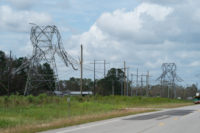
We have entered one of the most dynamic moments in the history of the world’s power industry.
With nations smartly focused on sustainability, the surge of renewable energy from solar and wind projects as well as rising adoption of battery storage, microgrids and other distributed energy resources (DERs) are pushing the grid further from its legacy power roots.
To deliver upon the “always on” mandate consumers expect, it’s time to embrace the kind of “re-powering” the more-than-century-old power industry desperately needs.
Today’s energy world increasingly favors consumers while testing the historic and centralized business model of one-way power flows from utility to customer. For instance, we are seeing a rising number of enterprise, commercial and industrial customers explore their options as they seek to cut utility expenses, or enhance sustainability and resiliency through strategies like self-generation via rooftop solar, microgrids and battery storage.
Others are exploring power-purchase agreements (PPAs) and virtual PPAs that allow them to source green energy directly or are turning to predictive analytics software solutions to depict how power is used across their systems, optimize it, and in some cases earn revenue by selling excess energy back to the grid.
Led in part by the United Nation’s Sustainable Development Goals, this culture of “new energy” prizes clean energy technology, innovation, and above all else, a reliable and resilient supply of quality power at the lowest possible price. In turn, these goals spark calls for tailored solutions that balance conventional and renewable generation sources, as well as more distributed, power sources and grid infrastructure.
At Black & Veatch, we recently reorganized our global power business to elevate our focus on renewables, distributed energy resources and power distribution as these market forces aggressively push the grid and many of our clients in new directions.
From North America to Europe to Southeast Asia, population growth and energy reliability demands are stoking power solutions ranging from zero-carbon generation sources – energy from solar and wind -- to natural gas solutions that act as a baseload bridge to the renewables future. It's not a giant stretch, however, to envision the moment when high-capacity batteries can help renewables behave more like baseload power. Consider that in the United States, utility-scale solar PV and storage investments are well underway in sunshine-rich states like Arizona, California, Florida, Hawaii and Texas. In Arizona and Colorado, renewable projects with solar power PPAs signed for solar-plus-storage have become more economically feasible than renewables-only solutions.
In working with clients of differing scale and development it’s become clear that generation, transmission and distribution can no longer operate in isolation. Demand for renewable energy continues to grow, with its generation now impacting the operations of the traditional transmission and distribution sectors. Investments in distributed energy require a more flexible grid to ensure reliability and offer clients a greater choice of power generation solutions.
Our annual survey-driven Strategic Directions: Electric Report takes a snapshot of the industry, and this year’s survey of nearly 900 North American leaders in the industry – the most comprehensive sampling by Black & Veatch in our more than decade-long series of reports – provided a compelling snapshot of the power sector’s re-boot:
- Almost half said renewables and distributed generation were motivating utilities to retire central generation sites, with nearly one-third saying they expect that to happen in the near term.
- About 40 percent said the primary driver for distribution markets was that they’d serve as a “strategy for accelerating the transition to a more distributed grid model.” More than half — 55 percent — believed that DERs would dominate utility service offerings by 2035.
- When asked what tools or resources are most essential for the planning, engineering, construction, operation and maintenance of a more complex grid, 55 percent of respondents cited innovative system designs that allow for more system flexibility. More than half — 53 percent — cited better modeling and forecasting data and programs.
- As the electrification of business-class vehicle fleets gains momentum, it can take years to plan for and deliver the power needed to keep the fleets’ wheels rolling and move the commercial EV market to mainstream. More than half of the survey’s respondents already are very engaged with their local transit agencies about electrification. Nearly one-quarter said they’re just starting to have such talks.
New energy continues to disrupt the electric industry as consumers, in the pursuit of energy independence and lower costs, march further toward a greener grid. It will be crucial to not only have a balanced generation mix with diverse fuel sources, but also to invest in distributed generation, transmission and distribution as these systems no longer operate in isolation.
Now more than ever, power providers must recognize and embrace these challenges and reconsider the effectiveness of a business model whose time has come and gone.
Mario Azar is president of the global power division at Black & Veatch.





Post a comment to this article
Report Abusive Comment